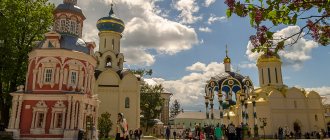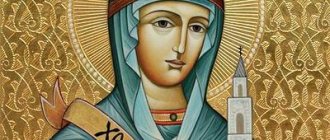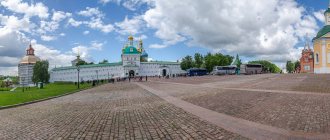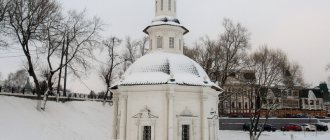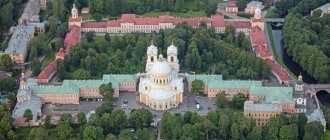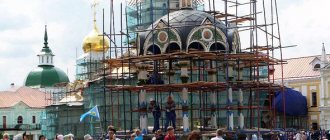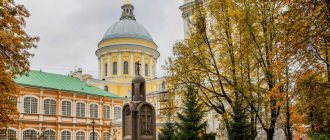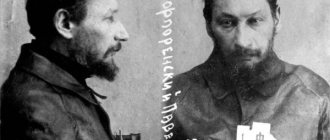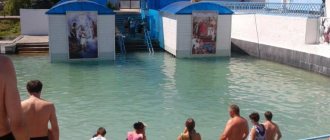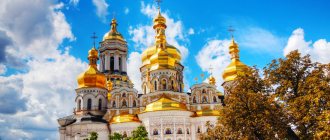Monastery under Sergius of Radonezh
A number of historical sources, including the well-known Tale of Bygone Years, show that the lonely existence of Sergius of Radonezh lasted no more than 5-7 years. Already around 1342-1345. Other inhabitants appeared on Makovets Hill - monks. As a result, the wasteland became a special monastery.
On a note! This form of residence assumed that each monk had personal property, but at the same time, the dwellings of the inhabitants of the wasteland remained common. At a certain time, all the monks gathered in one place for worship, held several times a day.
The exclusive monastery on Makovets existed until 1354 or until 1364. The exact time is unknown. But presumably it was precisely during the period, that is, between 1354-1364, and possibly in 1376, with the blessing of the Patriarch of Constantinople Philotheus, that the cenobitic monastery was formed. The monks lost their personal property and from now on did everything only together.
In the place chosen for the monastery they rebuilt from wood:
- Church of the Holy Trinity;
- refectory;
- cells;
- outbuildings;
- Church of Demetrius of Thessalonica;
- fence.
Companions of Radonezh planted vegetable gardens and started a small farm. The first abbot of the monastery on the hill was not Radonezhsky, but a certain Mitrofan, who, by the way, tonsured Radonezhsky a monk. But after the death of Mitrofan, the monastery came under the control of Sergius, under whose leadership it very quickly turned into the spiritual center of the Russian lands.
Fun fact! It was at the walls of the Trinity-Sergius Monastery that Dmitry Donskoy stopped to receive parting words and blessings for the Battle of Kulikovo. And Sergius of Radonezh, violating the charter, sent with the prince the monks-heroes - Peresvet and Weasel, who largely changed the course of the battle.
Sergius of Radonezh reposed in 1392. He was buried within the walls of the Church of the Holy Trinity. The reverend's favorite disciple, Nikon of Radonezh, became the new abbot.
Trinity-Sergius Lavra in the XV-XVI centuries: the first stone structures
A whole century has passed since the founding of the monastery after the death of the founder, and already at the beginning of the 15th century the Trinity-Sergius Lavra appears to the invisible spectator in the form of a complex of several, including stone, buildings. The construction of the latter on the territory of the monastery began after it was burned by Khan Edigei in 1408. The first stone structure appeared in 1422. It became the Trinity Cathedral.
It was built by Serbian monks who settled within the walls of the monastery after the Battle of Kosovo. The temple was painted by Andrei Rublev and Daniil Cherny; the first one also painted the iconostasis, where his famous “Trinity” appeared.
The second stone structure on the territory of the monastery was a two-story refectory building. It was erected by the Moscow architect Vasily Ermolin. In 1540, the construction of stone walls began around the monastery. A decade later, the 1.5 km long fence was completely built.
At the same time, the monks created dams and dug a pond, which turned the Trinity-Sergius Lavra into one of the most powerful medieval fortresses. In 1559, the first stone was laid for the foundation of the Assumption Cathedral on the territory of the Lavra. It was illuminated only in 1585, since rapid construction was prevented by a strong fire in 1565, after which not much remained of the former monastery, and everything had to be rebuilt.
In 1561, the monastery was given the status of archimandrite, which was quite justified, since it was to the walls of the Trinity-Sergius Lavra that the prince and the first kings came for advice and consolation. It was here that the future Ivan the Terrible was baptized in 1530, and earlier, in 1442, during the period of internecine wars, reconciliation between Vasily II and his cousin Dmitry Shemyaka took place.
True, the peace did not last long. Two years later, Vasily was captured by Dmitry’s people here at the tomb of Sergius of Radonezh. He was taken to Moscow, blinded and then transported to Uglich.
On a note! By the end of the 16th century, the Trinity-Sergius Lavra became the largest monastery on the territory of the Moscow Principality. The monks owned about 3 thousand different settlements. The brethren also had their own merchant ships at their disposal. The monks conducted active trade with foreign countries, simultaneously strengthening useful political relations.
Development of the monastery in the 17th - early 18th centuries
The beginning of the 17th century was a time of great unrest and intervention, and this trouble also affected the monks. In 1608 the monastery was besieged by the Poles. The brethren defended themselves for 2 years, finally waiting until the siege was lifted by the troops of Mikhail Skopin-Shuisky.
After this, the Trinity-Sergius Lavra turned into a stronghold for the Second Militia under the leadership of Minin and Pozharsky. Archimandrite Dionysius helped the militias in word and deed. The wealth of the monastery decreased somewhat, but thanks to the generous donations that followed after the siege was lifted, the Trinity-Sergius Lavra was quickly rebuilt.
It was at this time that the walls and towers of the monastery acquired the appearance that modern people see. New buildings have appeared, for example:
- bell tower at the Spiritual Church;
- Church of Mikhail Malein;
- royal mansions;
- stone two-story cells;
- Church of Zosima and Savvaty;
- hospital wards.
After the last siege of the monastery in 1618, the Trinity-Sergius Lavra increased to incredible limits. The monks owned almost 17 thousand serfs, the monastery had more land than the patriarch or even the king.
The monks were engaged in breeding and selling fish, ground flour in their own mills, made bricks in their own brick factories, and collected fruits in the gardens. They also actively participated in the political life of the country. At different times, Sofya Alekseevna, as well as her brothers Peter and Ivan, sought shelter within the walls of the monastery. Peter, in particular, hid in the monastery in 1689. He left it in order to become a sovereign ruler, but did not forget the services, ordering the construction of a beautiful refectory and the temple of St. Sergius of Radonezh - the Refectory Church.
On a note! At the same time, near the eastern wall of the monastery, the Stroganovs erected the over-square Church of the Nativity of John the Baptist.
The beginning of the 18th century was not the most successful for the monastery. At this time, Peter I began building the future of St. Petersburg and got involved in the Northern War. The treasury was in dire need of money, part of which the ruler borrowed from the Lavra. In addition, stone construction was prohibited, since all the material was spent on the construction of the new capital.
But in 1708, there was a threat of Swedes penetrating deep into the country, as a result of which bastions, ditches and new fortifications were built around the walls of the monastery. As a result, after the reign
Peter I Trinity-Sergius Lavra ceases to be a stronghold of the spiritual power of the kings, people stopped admiring it and even talked about moving the monastery to another place. Perhaps this is due to its, one might say, respecialization from a holy building to a military-defensive one.
The heyday of the Lavra
A new round of interest in monastic life arose during the reign of Elizabeth Petrovna. By her order, a theological seminary was opened within the walls of the Lavra in 1742. It was under Peter’s daughter that the monastery received the honorary title – “Lavra”. It was headed by the Metropolitan of Moscow. Elizabeth loved the monastery with all her soul; her frequent visits were accompanied by festivities and fireworks.
The ruler supported the idea of completely rebuilding the monastery; prominent architects of that time worked on the project. The restoration work that began under her continued under Catherine II. And now the restored monastery buildings began to resemble palaces, and not places of residence for monks and ordinary people who had moved away from the bustle of the world.
On a note! The bright colors of the buildings emphasized the gilding of the stucco. In 1792, an obelisk with a medallion appeared in the central part of the monastery, telling the story of the ancient history of the monastery. The obelisk was also used as a chronometer, as a sundial was built on each of its three sides.
In the 19th century, the Lavra re-emerged as the richest monastery in the country. By the middle of the century, the monastery already owned over 100 thousand serfs. The wealth of the Lavra consisted mainly of donations, as well as profits from trade. At the same time, the monks themselves never hesitated to contribute.
Note! In 1812, the Lavra gave the Russian army about 70 thousand rubles as support, which was a fabulous sum in those days.
Monastery in the 20th century
At the beginning of the 20th century, the position of the Trinity-Sergius Lavra, as a cultural and educational center, the richest of the Orthodox monasteries, almost did not change. During a wave of peasant ransoms, the brethren lost many serfs, but they still owned vast territories, workshops, factories, and a printing house.
In 1910, about 400 monks still live within the walls of the monastery, and the relics of many saints are kept. The Lavra became the last refuge for a number of Russian princes, for example, Prince Dmitry Trubetskoy, Prokopiy Lyapunov, representatives of the Godunov family and other eminent families were buried in its crypts.
But after the revolution of 1917, the monastery was closed, the Moscow Theological Academy was dissolved, and the premises it occupied were allocated for electrical engineering courses. The relics of Sergius of Radonezh were uncovered, and the monastery was turned into a museum. The remaining brethren were resettled in labor communes.
The last service on the territory of the monastery was held at the end of May 1920, after which the monastery finally became a museum. The bells were melted down, and the students of the pedagogical institute were transferred to the territory of the monastery.
Restoration of the Lavra
Immediately after the end of active hostilities in 1917-1918. In the area adjacent to the monastery, the Bolsheviks created a commission to protect the ancient valuables that were kept in the monastery, as well as organizations to carry out restoration work. But this work was carried out very poorly, since there was no single idea of what the new monastery should look like and why it was needed at all.
On a note! Systematic restoration work began only in 1938 after the young architect Ignatius Trofimov was invited to participate in it.
It took Trofimov two years to prepare a certificate about the museum and a project for restoration work. On February 1, 1940, the Lavra and the surrounding territory were declared the Zagorsk State Historical and Art Museum-Reserve. Trofimov was appointed chief architect, allocating 6 million rubles for restoration.
The war prevented its completion. But despite the hostilities and post-war devastation, the destruction of the monastery was avoided. Some of the monuments were restored, while others were built almost from scratch.
Restoring the Lavra is the primary and most important task that the government set before Trofimov. In 1950 Trofimov’s work was continued by his student, architect V.I. Baldin. In 1963, A.G. got involved in the case. Ustinov, who insisted on a comprehensive restoration of the Lavra ensemble. By the beginning of the 1970s. Most of the restoration work was completed, but the restoration of the monastery did not stop there.
The work of the first architects was continued by the younger generation. Many parts of the monastery can now be seen thanks to the work of architects Yu.D. Belyaeva and Yu.N. Shakhova.
In 1990-2000 The Lavra was restored to its original pre-revolutionary appearance, some walls were repainted, the previous painting was recreated, and the bell tower was repaired. In 2004, the Tsar Bell returned to the bell tower. It had to be cast again because the previous one was melted.
Important! In 1993, UNESCO included the Trinity-Sergius Monastery on the list of world cultural heritage.
Trinity Cathedral
This white-stone single-domed cathedral is the oldest stone temple building in the ensemble, erected in 1422-1423. instead of a wooden church, illuminated by the Rev.
Its structure is fully consistent with the churches of this period: the walls of the temple end with keel-shaped zakomaras with kokoshniks. The helmet-shaped dome is built on a high drum in the shape of a tower with narrow windows. The walls of the temple are decorated with a laconic monochrome pattern.
The interior of the Trinity Cathedral deserves special attention. It represents an engineering innovation of that time, created in violation of traditional ancient Russian canons in favor of the idea of aspiration upward.
Initially, the frescoes of the cathedral were painted by Daniil Cherny and Andrei Rublev, but in the 17th century they were covered and rewritten.
The iconostasis is of enormous artistic value - icon painters of the Rublev school worked on its creation together with its founder. This beautiful light iconostasis consists of 40 icons and was the first multi-tiered one in Rus'.
Take note: the sacred shrine for the relics of Sergius is made of silver with gilding, over the shrine there is a canopy built on pillars made of 400 kg of pure silver. The order to create the canopy and shrine was made by Anna Ioannovna in the second third of the 18th century.
For him, Andrei Rublev wrote “Trinity” in 1422, which today can be seen in the State Tretyakov Gallery. The main treasure of the cathedral is the tomb with the holy relics of the saint and some of his belongings.
Religious life of the Trinity Lavra of Sergius
After the revolution, many parishioners and monks doubted that they would ever be able to see the Lavra in its previous form and perform divine services within its walls. But after the victory in the Great Patriotic War, the attitude towards religion became more loyal. Opium turned out to be very useful for the people; monks and priests proved that in addition to physical food, people also needed spiritual food to win.
In 1946, monastic life was resumed on the territory of the Lavra. The patriarchal estate is also located here (until 1983). The relics of Sergius of Radonezh also returned to the Lavra. They were again placed in the Assumption Cathedral. The Church of St. Sergius of Radonezh, closed since 1921 in 1946, was consecrated anew.
Important! A fateful event for the brethren and the monastery as a whole occurred at the end of 1946. The Lavra was shown to the son of the US President, Eliot Roosevelt. From this time on, local authorities began to actively participate in the life of the monastery, insisting on carrying out more and more restoration work. But control and supervision over the activities of the Lavra still remained strict: believers were not trusted, and the territory of the monastery was visited by the police more than once.
According to the official website of the Trinity-Sergius Lavra, at the end of the 1950s. The monastery was given new buildings in the city of Zagorsk. The former residents were resettled at the expense of the Patriarchate. In November 1959, Patriarch Alexy I blessed the new Charter.
The beginning of the twentieth century - fate during the revolution
Until 1917, the life of the Holy Trinity Lavra of St. Sergius can be called active - it carried out spiritual and educational missions, it was the largest pilgrimage center in Tsarist Russia.
In 1919, after the revolutionary events, the monastery was closed and its property was nationalized. The monks are expelled along with the governor of the monastery. At the same time, the new government is aware of the historical and cultural value of the monastery.
To preserve the heritage and save it from looters, a commission is being created that is designed to evaluate the property of the Lavra from the point of view of its artistic and historical value. The commission included deeply religious people who not only described and evaluated, but also did everything possible to preserve the spiritual heritage.
It is important to know: after the nationalization of the Lavra’s property, monks became the new caretakers and watchmen. A huge amount of work was undertaken to preserve the heritage and especially the relics of St. Sergius. For many years, some of the relics were hidden; everything was done to prevent them from being desecrated and destroyed.
In the 1920s, a museum was opened here, which later acquired the status of anti-religious. The main struggle unfolded around the relics of St. Sergius, which for several decades were exhibited as the main exhibit of the museum. The Zagorsk Museum of History and Local Lore, as the place was now called, gradually deteriorated, the buildings were destroyed and lost their original appearance, many buildings were rebuilt into living quarters, schools and warehouses.
Educational institutions on the territory of the monastery
In 1742, Elizaveta Petrovna ordered the opening of the first educational institution on the territory of the monastery. It became the Trinity Lavra Theological Seminary. The first experience turned out to be positive, because in subsequent decades and even centuries the monastery walls hosted students. Worthy of attention:
- Moscow Theological Academy (1814 - 1917);
- Schools of icon painting (1885 -1917);
- Moscow Theological Seminary (1989).
Note! In the first years of Soviet power, various schools were located on the territory of the monastery, which had nothing to do with students receiving spiritual education.
Modern life in the Lavra
Up to 200 monks permanently live within the walls of the modern monastery complex. In 2022, Foma (Demchuk) became governor. The Archimandrite is the Patriarch of Moscow and All Rus'. The Lavra has been governed by the Spiritual Cathedral since 1897. This is a collegial body.
On the territory of the Trinity-Sergius Monastery there are:
- Water tower (built in the 17th century);
- Bell tower (XVI-XVII centuries);
- Blagoveshchenskoye Compound;
- Bogorodskoye Compound;
- White stone workshop;
- Stained glass workshop.
Modern hotels have been built for pilgrims, as reported on the official website of the Trinity-Sergius Lavra.
Assumption Cathedral
One of the most expressive buildings of the Lavra - the Assumption Cathedral - was erected by decree of John IV in 1559-1585. The five-domed, laconic and at the same time elegant appearance of the cathedral is crowned with azure and gold onion-shaped domes with stars.
Made according to the canons of Vladimir-Suzdal architecture, the temple demonstrates a white stone arched-columnar belt. The arrangement of the Assumption Church was carried out under Tsar Fyodor Ioannovich, outstanding icon painters of the 17th century worked on the frescoes and iconostasis - Simon Ushakov, Dmitry Grigoriev and representatives of their icon painting school.
Interesting fact: the azure domes of the Assumption Cathedral with stars indicate a connection with the Mother of God and the Nativity of Christ, whose birth was marked by the Star of Bethlehem.
On the western side, on the porch of the cathedral, Boris Godunov and his family are buried. After the destruction of the porch, a white stone tent-tomb was erected over the burial.
Abbots and governors
From 1344 to 1560 35 abbots were replaced, and from 1561 to 1766. 34 Archimandrite. The current governor, Thomas, is already 41 in the ranks of his predecessors. He is the vicar of the Patriarch of Moscow, formally considered the main monastery.
It is interesting that only 16 primates of the Russian Orthodox Church before the current Patriarch of Moscow headed the Lavra, among them are such famous ones as Metropolitan Philaret and Patriarch Tikhon, who entered into open confrontation with the Bolsheviks over the position of the Russian Orthodox Church in the state.
Information for the pilgrim
All information of interest to believers and pilgrims can be found on the official website of the Trinity-Sergius Lavra. We have selected the most useful one for you and are ready to share it with you.
How to get there
The Lavra is located in the Moscow region in the city of Sergiev Posad. Phone number of the monastery entrance. You can call 24 hours a day. In order to get to the place, at the Yaroslavsky station in Moscow you need to take a commuter train and ride it to Sergiev Posad. You can also take a shuttle bus. To do this, you need to get to the Shchelkovsky bus station by metro (Shchelkovskaya station or VDNH).
Information telephone number of the railway station in Sergiev Posad - (496) 540-58-78, bus station -.
Where to stay
There are two hotels at the service of pilgrims - Voznesenskaya and Pilgrimcheskaya at the Resurrection Metochion. Voznesenskaya hotel is located on the street. Voznesenskaya in the historical center of Sergiev Posad. To book a room at the Pilgrimage Hotel, you need to go to the address 1st Shock Army Street, building 17.
You can also call, for the Voznesenskaya Hotel - 7;, for the Pilgrimcheskaya Hotel - +7 (496) 547-36-45. There is parking. But the schedule of visiting and accommodation needs to be clarified.
What services are held at the Trinity-Sergius Lavra
It is better to find out the schedule of the Trinity-Sergius Lavra in advance on the website. The service runs from Monday to Saturday. Among other things, custom prayer services are held, as well as prayer services with an akathist at the shrine of St. Sergius. Prayer services begin at 8.30 and end at approximately 20.00.
At the Sunday courtyard, the Undying Psalter and Unction are performed. Memorial services are served after the end of the early and late Liturgies.
Reviews and comments from tourists, pilgrims and ordinary visitors
Anastasia: “On the territory of the monastery there is the impressively beautiful Trinity Cathedral, and this is its main attraction. It’s hard to call me a believer, but even I was amazed. It is also a historical relic; it was interesting to take a closer look at it. The high ancient walls and domes were impressive. It is not for nothing that the Lavra today, yesterday and even tomorrow played and is playing a major role in the spiritual enlightenment of people.”
Dmitry: “I visited the Lavra for the first time. Today my childhood dream came true. I never regretted it, even though I traveled quite far. The only thing I was worried about was the place to stay, but it turns out that the monastery also includes two hotels where you can stay comfortably.”
Sergey: “The Lavra is impressive in its scale. When I imagine that all this was still being built when Mamai went to Rus', it fills me with indescribable delight. The priests are friendly, I accepted confession.”
The Trinity Lavra of St. Sergius is the center of Russian Orthodoxy. It was founded by Sergius of Radonezh at the beginning of the 14th century. Since then, the monastery has been rebuilt and restored, but has managed to preserve both its spiritual and historical significance. Every year hundreds of thousands of pilgrims from all over the world come to the Lavra. Many people strive to join the holy relics of Sergius of Radonezh.
XV-XVI centuries – construction of stone buildings
In the XV-XVI centuries the monastery expanded significantly. Its center was the Trinity Cathedral, located on the site of the first wooden church, built during the life of Sergius. The cathedral is an outstanding monument of ancient Russian architecture - frescoes were painted by Andrei Rublev and icon painters of his circle.
Trinity Cathedral
The cathedral houses the holy relics of St. Sergius. The cathedral became one of the first stone buildings of the monastery, later it was joined by the Nikon Church with the relics of St. Nikon, the Serapion Tent with the holy relics of the monastery abbots who followed Nikon, a particle of the relics of St. Andrew the First-Called, the pectoral cross of St. Sergius of Radonezh and other shrines.
Pskov architects erected a one-domed church in the monastery in honor of the Descent of the Holy Spirit on the Apostles. Today it is one of the oldest surviving churches - a monument of ancient Russian architecture from the period of fragmentation of Rus'. This church, which has the short name Dukhovskaya, houses the relics of Anthony of Radonezh, who became the abbot of the monastery with the blessing of Seraphim of Sarov.
Five-domed Church of the Dormition of the Mother of God
By order of Ivan the Terrible, the five-domed Church of the Dormition of the Mother of God was founded and built in the monastery - the most grandiose temple in the architectural appearance of the Lavra. Its prototype was the Assumption Cathedral of the Moscow Kremlin.
Interesting fact: under the impressive walls of the Assumption Cathedral is the Church of All Saints - this is an underground temple for the monks of the Lavra. On the western side of the cathedral you can see the tomb of the family of Boris Godunov, who left a significant mark on Russian history.
Until the middle of the 16th century, the walls surrounding the monastery were wooden. Over ten years, from 1540 to 1550, new brick walls with towers were erected to repel military attacks. The monastery began to resemble a fortress and became an impregnable spiritual abode. Spiritual life was still in full swing inside the monastery; it became the largest Orthodox center of that time.

